

A connection point is an object point that is used to link it with another object.
A line is a workspace object that determines correspondence between objects by connection points. Lines can be created with arrows at the end or without.
There are five basic connection points for workspace objects (except for lines and polygons):


A line connected to such a point remains anchored to this point regardless of the object position. Central connection point is floating, that is, the link is anchored to one of the perimeter points depending on the object position.
In the desktop application connection points can be edited. To edit:
Activate the edit mode of connection points:
Click the ![]() Edit Connection Points button on the Home ribbon tab.
Edit Connection Points button on the Home ribbon tab.
Press ALT+7.
Using the mouse, select an object which connection points will be edited.
Select:
Moving connection points by object outline. To do it, select a point using the mouse and, while holding the mouse button, move the cursor by object outline.
Copying connection points. To do it move the point while holding the CTRL button. In this case object borders can hold infinite number of connection points.
Deleting connection points. To do it, select the point with the mouse button while holding the DELETE button.
To create a line between objects, do the following:
Activate the line creation mode.
Select line type in the drop-down menu of the button containing a set of lines on the toolbar:
 . Straight line.
. Straight line.
 . Arrow.
. Arrow.
 . Angular line.
. Angular line.
 . Curved line.
. Curved line.
NOTE. Line selection button looks like the last selected line type.
Select the line type:
Line. It creates a straight line between objects by connection points. To create a line:
Click the  Line button on the Home ribbon tab and select the Line option in the drop-down list.
Line button on the Home ribbon tab and select the Line option in the drop-down list.
Press ALT+2.
Link. It creates a link between objects by connection points. It is visually presented as straight line with arrow without angles. To create a link:
Click the  Line button on the Home ribbon tab and select the Link option in the drop-down list.
Line button on the Home ribbon tab and select the Link option in the drop-down list.
Press ALT+3;
Connecting Line. It creates a line between objects by connection points that is automatically changed to the straight line with right angles. To create a connecting line:
Click the  Line button on the Home ribbon tab and select the Connecting Line option in the drop-down list.
Line button on the Home ribbon tab and select the Connecting Line option in the drop-down list.
Press ALT+4.
Curved Line. It creates a curved line between objects by connection points. To create a curved line:
Click the  Line button on the Home ribbon tab and select the Curved Line option in the drop-down list.
Line button on the Home ribbon tab and select the Curved Line option in the drop-down list.
Press ALT+5.
Press and hold down the CTRL key while moving the cursor from connection point of one object to connection point of another object.
After activating any of modes, move the mouse cursor to one of the object connection points. In the web application the point will be doubled in size, and in the desktop application it will be highlighted with color. Click and hold down the mouse button:


Then hold down the mouse button and move the cursor to the connection point of other object:
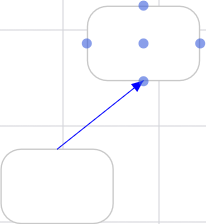
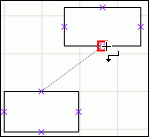
To create a connecting curved line, hold down the CTRL key when moving the cursor from the connection point of one object to the connection point of other object.
Release the mouse button. The line is built:
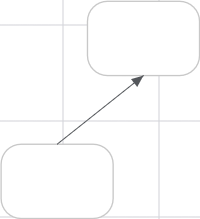
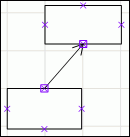
In the web application after creating a straight line/arrow, an additional point is displayed at its center that can be used to create a broken line. To do this, drag the additional point located at the center of the line to the other place in the working area if it is required to create a broken line. Additional points are displayed at each new linear segment:
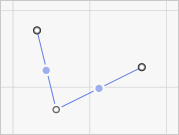
To remove the additional point, double-click the point.
NOTE. Lines can be created in any workspace place without linking to connection points.
See also: